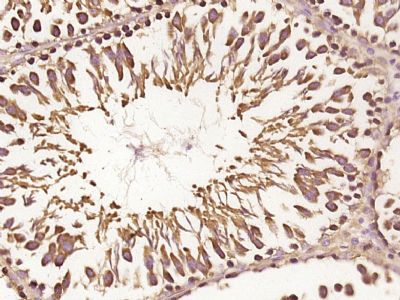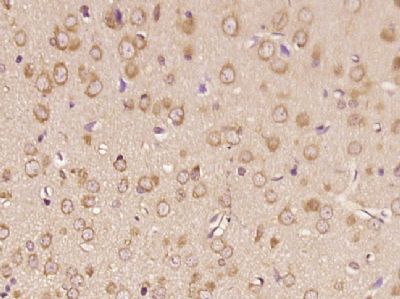RNF170 Polyclonal Antibody
Purified Rabbit Polyclonal Antibody (Pab)
- 产品详情
- 实验流程
Application
| IHC-P, IHC-F, IF, E |
|---|---|
| Primary Accession | Q96K19 |
| Reactivity | Rat, Dog, Bovine |
| Host | Rabbit |
| Clonality | Polyclonal |
| Calculated MW | 29815 Da |
| Physical State | Liquid |
| Immunogen | KLH conjugated synthetic peptide derived from human RNF170 |
| Epitope Specificity | 101-200/258 |
| Isotype | IgG |
| Purity | affinity purified by Protein A |
| Buffer | 0.01M TBS (pH7.4) with 1% BSA, 0.02% Proclin300 and 50% Glycerol. |
| SUBCELLULAR LOCATION | Endoplasmic reticulum membrane; Multi-pass membrane protein (By similarity). |
| SIMILARITY | Contains 1 RING-type zinc finger. |
| SUBUNIT | Constitutively associated with the ERLIN1/ERLIN 2 complex. Interacts with activated ITPR1. |
| DISEASE | Defects in RNF170 are the cause of ataxia, sensory, type 1, autosomal dominant (SNAX1) [MIM:608984]. A rare disease characterized by progressive ataxia caused by degeneration of the posterior columns of the spinal cord. Affected individuals have a reduced ability to feel pain, temperature and vibration, particularly in the hands and feet. Their most prominent feature is an ataxic gait resulting from a severe loss of proprioception. Thus, patients rely on visual cues for maintaining proper body posture, such that they are unable to remain upright if their eyes are closed (Romberg sign). |
| Important Note | This product as supplied is intended for research use only, not for use in human, therapeutic or diagnostic applications. |
| Background Descriptions | The ring finger is a specialized type of zinc finger of 40 to 60 residues that binds two atoms of zinc and mediates protein-protein interactions. There are five known isoforms of RNF170. |
| Gene ID | 81790 |
|---|---|
| Other Names | E3 ubiquitin-protein ligase RNF170, 2.3.2.27, Putative LAG1-interacting protein, RING finger protein 170, RING-type E3 ubiquitin transferase RNF170, RNF170 |
| Target/Specificity | Expressed in the spinal chord. |
| Dilution | IHC-P=1:100-500,IHC-F=1:100-500,IF=1:50-200,ELISA=1:5000-10000 |
| Format | 0.01M TBS(pH7.4) with 1% BSA, 0.09% (W/V) sodium azide and 50% Glyce |
| Storage | Store at -20 °C for one year. Avoid repeated freeze/thaw cycles. When reconstituted in sterile pH 7.4 0.01M PBS or diluent of antibody the antibody is stable for at least two weeks at 2-4 °C. |
| Name | RNF170 |
|---|---|
| Function | E3 ubiquitin-protein ligase that plays an essential role in stimulus-induced inositol 1,4,5-trisphosphate receptor type 1 (ITPR1) ubiquitination and degradation via the endoplasmic reticulum-associated degradation (ERAD) pathway. Also involved in ITPR1 turnover in resting cells. Selectively inhibits the TLR3-triggered innate immune response by promoting the 'Lys-48'-linked polyubiquitination and degradation of TLR3 (PubMed:31076723). |
| Cellular Location | Endoplasmic reticulum membrane; Multi-pass membrane protein |
| Tissue Location | Expressed in the spinal cord. |
Research Areas
For Research Use Only. Not For Use In Diagnostic Procedures.
Application Protocols
Provided below are standard protocols that you may find useful for product applications.
终于等到您。ABCEPTA(百远生物)抗体产品。
点击下方“我要评价 ”按钮提交您的反馈信息,您的反馈和评价是我们最宝贵的财富之一,
我们将在1-3个工作日内处理您的反馈信息。
如有疑问,联系:0512-88856768 tech-china@abcepta.com.
¥ 1,500.00
Cat# AP59201























 癌症的基本特征包括细胞增殖、血管生成、迁移、凋亡逃避机制和细胞永生等。找到癌症发生过程中这些通路的关键标记物和对应的抗体用于检测至关重要。
癌症的基本特征包括细胞增殖、血管生成、迁移、凋亡逃避机制和细胞永生等。找到癌症发生过程中这些通路的关键标记物和对应的抗体用于检测至关重要。 为您推荐一个泛素化位点预测神器——泛素化分析工具,可以为您的蛋白的泛素化位点作出预测和评分。
为您推荐一个泛素化位点预测神器——泛素化分析工具,可以为您的蛋白的泛素化位点作出预测和评分。 细胞自噬受体图形绘图工具为你的蛋白的细胞受体结合位点作出预测和评分,识别结合到自噬通路中的蛋白是非常重要的,便于让我们理解自噬在正常生理、病理过程中的作用,如发育、细胞分化、神经退化性疾病、压力条件下、感染和癌症。
细胞自噬受体图形绘图工具为你的蛋白的细胞受体结合位点作出预测和评分,识别结合到自噬通路中的蛋白是非常重要的,便于让我们理解自噬在正常生理、病理过程中的作用,如发育、细胞分化、神经退化性疾病、压力条件下、感染和癌症。







